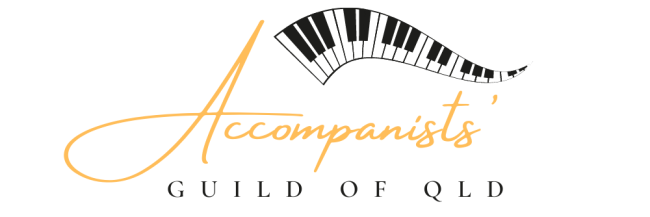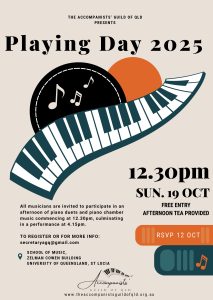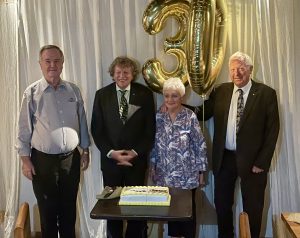- Practice with a singer on piano — much as it is often done on guitar like strumming — so, you will follow the singers lead and not:
- Need to play the notes of the “melody” while the singer is voicing them,
- Or set the “tempo” as the soloist may have slow and fast parts for emphasis, etc.
- Or decide the “rhythm” if the singer has an interpretation,
- So, you do not decide the “style”… Don’t do the singer’s job.
-
2
Play non-obnoxiously (not too loudly) as the basic technique. Think about accompanying in a group with a guitar player who can lightly strum chords while the drummer may use brushes or soft drumming style, etc. but of course some singers, as an alternative, may have a style where the instruments are pretty loud…
-
3
Lighten up as a piano accompanist and even just use one hand to play the rhythm while chording so that it is not like “clump, clump…” explained in detail below. Using the piano for accompanying will often involve both hands for turn around parts, left hand or right hand chording variations, ideas like the Circle of Fifths, and adapting to what your soloist does by recognizing the style and responding to the tempo, rhythm and style by ear. You probably (but not necessarily) need to do an introduction with both hands and do an ending.
-
4
Use one hand to accompany on the piano. Sure there is more to learn to be a good piano accompanist. See chords in “Tips” below.
- It’s not just playing chords with one hand lightly — mostly using 3 tones called triad chords (see Chords, and Picturing the “Shapes of Chords” On Your Fingers and Hands — in the “Tips” section below)
-
5
Learn to break the chord into arpeggio (ar-pe-szhe-o), which means sounding of the notes of a chord in succession [perhaps rapidly] instead of simultaneously.
- Don’t hit the whole chord at once.
-
6
Practice rolling the notes by rocking or swaying your hand and fingers: going through each chord to play the notes separately.
- You don’t make the chords as clumping sounds.
-
7
Think of a mental picture of the fingers as forming the same “shape” of
- each three note chord like a 3 pronged fork or tripod and
- a four note chord (7th) as a four pronged fork.
-
8
Experiment playing “near” middle C, and down an octave (or maybe up) from there to fit your chording to the singer(s).
-
9
Learn to get the chord from the key signatures.You will see a pattern in the key signatures as they progress by every fifth lettered key/note in the “circle of fifths”.
- So, each key is in a musical interval (spacing) referred to as fifth from its neighboring key (just counting, not fractions).
- In the key signatures that contain flats, the name of the key is “the flat to the left of the last flat.” A key signature with four flats, B, E, A, D, for example, is the key of A flat.
-
10
Write the chord changes above the words on a written or printed page like it is done for guitar. There is a studio-professional way to do that using Nashville lead sheet notations. It is for a rhythm section (usually consisting of piano, guitar, drums and bass). The musicians practice to be able to improvise to present the chord in a blend with other instruments. That numbered method of notation allows musicians who are familiar with keys and chords to play the same song in any key that one knows without written sheet music.[1]
-
11
Interpret various piano styles by ear, and so you change tempo and the chord like for changing the key up or down as necessary. This is not an amateur trick: there is a free downloadable software created by Harvey Mudd College computer programming department for this kind of notational work for orchestras to use, etc.[2].
-
12
Leave the melody for the singer to do, and so you chord cleverly and rhythmically during the vocals (something like strumming, playing rhythm). So you hit individual notes of the chord as mentioned using a form of arpeggio (also called broken chords). That’s the technique in short, as the essence of the idea.
- See the pattern of the “Circle of Fifths” is based on counting every 5th note. In any part of “A” through “G” — then notes can be thought of as starting over forming a circle. After G, think of a, b, c, D, and so look at the circle and “G and “D” are fifths because there are 3 notes between them (counting 1, 2, 3, 4, 5) backward or forward.
- So you can count five in the musical alphabet: ignoring the three notes between the 1st and the 5th one. Then look at the circle and see “D and A are fifths”: D, e, f, g, A. That is how the key signature pattern works, and that shows how the circle got its name.
Help Singers Learn to Harmonize
-
1
Show two or more singers the harmony of the three most basic chords: “1,3,5” chords (which are just the key of C or key of F or key of G) which have no sharps, no flats, etc. The 1 represents the “root” (fundamental) note. The 3 represents “the 3rd,” or the note 2 places up. The 5 represents “the 5th,” which is 4 places up from the root and 2 places up from the 3rd. Each note skipped is called an interval (creating a pleasing separation between the ones that are sounded out).
-
2
Demonstrate chords to the singers and help them to hear how the different note combinations (chords) sound when working together. It’s easier to learn basics of harmony by hearing the notes played on a piano. Then one can start to sing along with the piano notes. Then they can move on to singing the harmony with another singer.
- A good step is to distinguish 2 or 3 singers each singing the melody an octave higher or lower than the other which is just singing in unison but is not harmonizing.
- For example: the male lead singing the melody an octave low “versus” a female soprano are in unison (not harmony). Singing unison is “layering,” and may enhance sound as in a choir (but a duet, trio or quartet is not normally unison, except for some special effect???).
-
3
Harmonize by singing “to the melody” but in a slightly lower or higher pitch to create a chord with voices.
- But, if a soloist sings a harmony note instead of the melody, that is a form of singing off key…
-
4
Add a 7th for a fourth voice in harmony and/or the 1st (or root) note, up one octave (for unison).
-
5
Learn the basic 1,3,5,7 major chord notes (C7, F7, G7 — see “Tips” below), as a group, and then you can help singers harmonize by their consistently carrying one of the chord notes; after they learn to hear them in the chord (and so they hear harmony) among voices. Bad harmony is being inconsistent, and so traveling from ones note to the note of someone else (off key).
- If there are more than 3 people you can have 2 or more singing each of the notes as in a choral group. Once you have a sense of the basics of harmonizing the “1, 3, 5 and 1, 3, 5, 7” you may experiment with other kinds of notes in other chords which have sharps or flats.
EditTips
- If there is a community college or junior college, then they probably have on campus or online continuing education for “non-credit” classes to learn music and get instruction to improve your techniques.
- Surprise, you can do it if you know several chords and if possible learn to play an intro, play chords mostly note by note (“arpeggi” which means “to play on a harp”) and do the ending without just stopping like hitting a wall.
- You can probably start helping a singer if you can do “C, D, F, G” and later you can add in “A” and the other ones that have more sharps and flats, as you practice piano without lessons and generally improve your skills in any area of your abilities.
Chords
-
Chords generally consist of at least “three” notes/pitches/tones (Let’s call them notes.) sounded together. If you speak of only two notes that are to be sounded then that is known as an interval (like a distance).
-
The simpler three note chords are major chords “C, F, and G” that are made up of only white keys spaces exactly the same way.
-
Notice that C chord is exactly the same shape as F and G chords in the photos using sticky notes on a keyboard above… but C shown as three notes on lines of sheet music would not show that concept.
- These three note chords are called triads or trichords formed by a “formula” like a pattern. Chords may have more than three notes (not needed for this basic accompaniment work): for example, a chord of 4, 5 or 6 notes are called tetrads, pentads and hexads (also called tetrachords, pentachords and hexachords).
- Also, some chords may be complicated by spaced out combinations of notes that are called “perfect,” “augmented,” or “diminished”, etc. for more complex chords.
-
Picturing the “Shapes of Chords” On Your Fingers and Hands
Two basic fingerings will work for all major, minor, 7th, major 7th and minor 7th chords for chording…
- First number the fingers and thumb of the left hand “5, 4, 3, 2, 1” starting at the little finger (5) going to the thumb (1).
Three Finger Major Chords Fingerings
- Then the shape of the hand for “C, F, and G” are all the same. That shape (like a formula) uses fingers “5, 3, and 1”. The other 3-note major chords use the samefingering shape:
- find the fundamental note (C or F or G), and
- go across the ivory keys to the third note using the third finger and
- to the ivory fifth note using the fifth finger (the thumb).
- So, the formula for those three chords is simply left to right on the left hand (5, 3, 1).
-
Notice that D chord is exactly the same shape as A in the photos using sticky notes on a keyboard at the left… but D shown as three notes on lines of sheet music does not show that idea. The shape of the handfor A or D chord is almost the same as C, F, or G — but A or D has the middle fingered-note “sharped” (“Sharping” or “flatting” is really only a half step between notes.). So, they both have a black key for the middle finger — left to right on the left hand (5, 3#, 1) where the “#” symbol means “sharp” which is most often the black key to the right…
- But, where two ivory keys are together (without a black one between them) then a white key is the sharp in some chords and scales.
- Flats work the same way but are moving down in the flow of the music.
- The combination for a chord of three or more notes sounded together at certain distances between the notes (like one step) are based on a pattern (or formula) for the chord like “5, 3, 1.”
- The same chords can be played on the right hand with the same kind of shape with the thumb and fingers again numbered left to right “1, 2, 3, 4, 5” but now starting from the thumb (1) to the right little finger (5);[3] and though it looks opposite — just ignore the thumb and finger switching, and so it is still the same shaped tripod(Note: both hands left to right are “5, 4, 3, 2, 1 and 1, 2, 3, 4, 5.”)
- So you can think of the numbering with right hand: “1, 3, 5” while the left was “5, 3, 1” (of course “1, 3#, 5” compared to “5, 3#, 1”, yet the shape is the same.
Four Finger Major 7th Chords Fingering
- The 7th chords are four note chords: The following fingerings work for all major and minor 7th chords (The 4th finger plays a 7th.) on the keyboard.
- For example: G7 Chord is found by counting G as 1st on The Circle then 1-3-5-7 makes that G-B-D-F see that all have an interval of one.
- Left hand fingering for this chord is 5-3-2-1 (just skip the “ring finger”). Pinkie – G, middle finger – B, index finger – D and thumb – F.
- Right hand is the same fingering “reversed” so it is 1-2-3-5 (again skip the “ring finger”). Thumb – G, index – B, middle – D and pinkie – F.
EditWarnings
- Make sure you are not setting the pace (tempo) like playing too slowly or too up tempofor the singers voicing: so then, you know you will always try to “follow” the singer.
- If the singer makes a remark like “You messed up!” take it as nerves and butterflies for the singer. Keep your cool and just say, “I’ll slow down!” or whatever it may be about.
EditRelated wikiHows
- How to Accompany a Performer
- How to Arpeggiate on Piano
- How to Be the Best Singer You Can Be
- How to Add Piano Chords to a Melody
- How to Sing
- How to Play Just Struttin Along on the Piano
EditSources and Citations
Article Info
Last edited:
September 29, 2012 by Ttrimm
Categories:
Piano and Keyboard
Recent edits by: BR, DifuWu, Manchurian President







